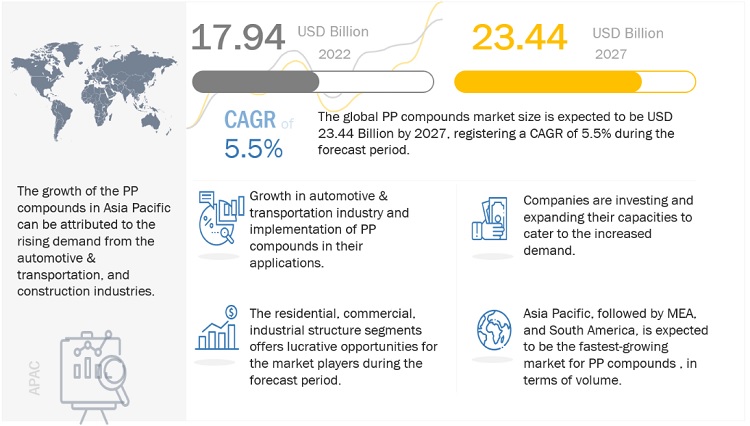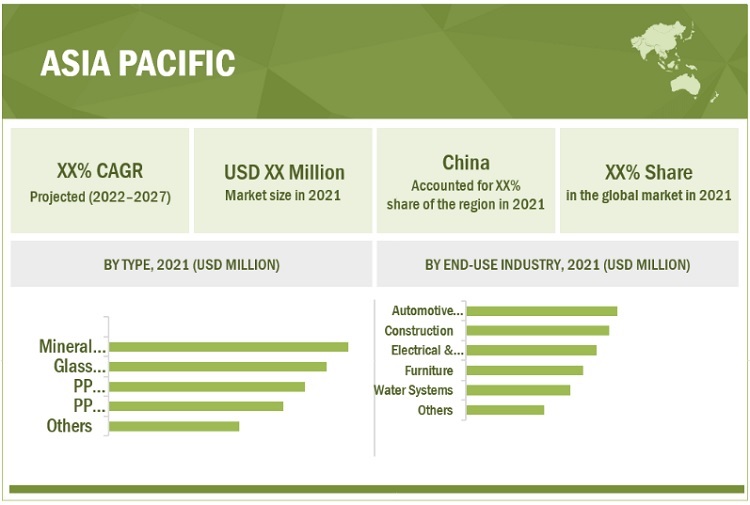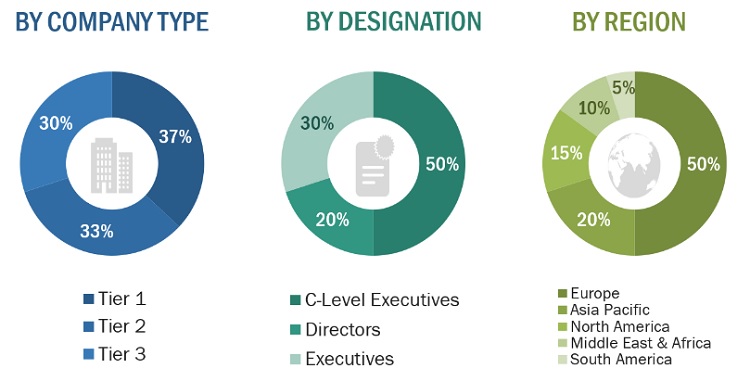Polypropylene (PP) Compounds Market by Product (Mineral Filled, Glass Fiber Reinforced, TPO & TPV Compound and Others, End-use (Automotive & Transportation, Electrical & Electronics) Construction, Furniture, Water Systems, Industrial and Others) and Region- Forecast to 2027
The polypropylene compounds market is projected to reach USD 23.44 billion by 2027, at a CAGR of 5.5% from USD 17.94 billion in 2022. Some of the major factors driving the growth of the market are increasing demand of polypropylene compounds from the automotive and construction industry in order to manufacture composites for various applications. Polypropylene possesses various properties, such as chemical resistance, fatigue resistance, transmissivity, and toughness. PP resin-based thermoplastic composites provide a competitive advantage over PA-based thermoplastic composites due to their lower price, superior physical properties, and lower specific gravity.
Attractive Opportunities in the Polypropylene Compounds Market

To know about the assumptions considered for the study, Request for Free Sample Report
Market Dynamics
Driver: Increasing demand for polypropylene compounds from consumer goods and electronics
Variety of PP thermoplastic composites have gained wide acceptance as a viable alternative to die castings and metal assemblies in industrial equipment, transportation, and consumer goods & electronics applications. The demand for PP composites is growing in the various end-use industries including consumer goods & electronics sectors, especially in the Asia Pacific region. Efficient qualities such as high impact strength, high rigidity at elevated and sub-zero temperature, less product rejection, good surface quality, and creep resistance under severe environments have fueled the use of PP composites in these applications.
Restraints: Difficulty in the fiber-reinforcement
PP products have a few disadvantages over thermoset compounds. PP composites have high processing temperatures and viscosity. There are some issues related to fiber wet out with thermoplastic PP composites. As PP composites have high molecular weight, it causes the materials to have a high glass transition temperature (Tg). Thus, it creates high melting viscosity. Such highly viscous materials prevent an easy fiber impregnation, that results in increased complexity in fiber wet out. The fiber wet-out process is complex and difficult than in the thermoset fiber reinforcement. This is a major disadvantage of PP thermoplastic composites.
Opportunities: Increasing demand for polypropylene compounds from emerging countries
There has been seen an increasing demand for PP compounds from emerging countries such as India, China, Brazil, and Mexico, in various end-use industries, such as construction, automotive & transportation, and electrical & electronics. Due to the increasing population, rapid urbanization and growing technological advancement, the usage of PP compounds, and thermoplastic composites used in these industries is showing significant growth.
Challenges: Development of low cost manufacturing technology
There are wide number of applications of PP compounds to manufacture composites. Price plays an important role in the acceptance of the products. The production of low-cost PP composites can increase the consumption of PP composites different end-use industries. The development of low-cost and innovative technologies is the need of the hour amongst all the research organizations and PP compound manufacturers. However, investment in research & development for the development of innovative, and new technology for producing PP composites is a major challenge for the market players.
“Automotive & transportation was the largest end-use industry of PP compounds market in 2021, in terms of value”
The automotive & transportation industry accounted for the largest share, in terms of value, in 2021 in global PP compounds market. These compounds are getting widely used in wide range of applications due to their superior mechanical properties and high impact resistance in automotive & transportation industry. The use of PP compounds also enables weight-reduction of vehicles.
“Asia Pacific was the largest market for PP compounds in 2021, in terms of value.”
Asia Pacific is the largest PP compounds market and is projected to register the significant CAGR, in terms of value and volume, between 2022 and 2027. The economic growth in the Asia Pacific region has resulted into high internal trade along with domestic transportation of supplies and commodities. Japan and China are some of the largest automobile producers across the world. These countries are competing and focusing on research & development in order to manufacture technologically advanced vehicles. Furthermore, the high growth of the electric vehicles is further driving the demand for PP compounds from the region.

To know about the assumptions considered for the study, download the pdf brochure
Key Market Players
The key players in this market SABIC (Saudi Arabia), Solvay (Belgium), ExxonMobil Corporation (US), Lyondellbasell (Netherlands), Trinseo (US), Chem Source Egypt (Egypt), Sumitomo Chemical (Japan), Washington Penn Plastics (US), and others. Continuous developments in the market—including new product launches, mergers & acquisitions, agreements, and expansions—are expected to help the market grow. Leading manufacturers of PP compounds market have opted for new product launches to sustain their market position.

Want to explore hidden markets that can drive new revenue in Polypropylene (PP) Compounds Market?
 Scope of the Report
Scope of the Report

Want to explore hidden markets that can drive new revenue in Polypropylene (PP) Compounds Market?

|
Report Metric |
Details |
|
|
|
|
|
|
|
|
|
|
|
|
|
The key players in this market are SABIC (Saudi Arabia), Solvay (Belgium), ExxonMobil Corporation (US), Lyondellbasell (Netherlands), Trinseo (US), Chem Source Egypt (Egypt), Sumitomo Chemical (Japan), Washington Penn Plastics (US), and others. |
This report categorizes the global polypropylene compounds market based on type, end-use, and region.
On the basis of type, the polypropylene compounds market has been segmented as follows:
- Mineral Filled PP Compounds (Talc, CaCo3, Glass Beed, Dolomite etc.)
- Glass Fiber Reinforced
- PP based Thermoplastic Polyolefins (TPO)
- PP based Thermoplastic Vulcanizates (TPE)
- Others
On the basis of end-use, the polypropylene compounds market has been segmented as follows:
- Automotive & Transportation
- Construction
- Electrical & Electronics (Consumer Goods)
- Furniture
- Water Systems
- Others
On the basis of region, the polypropylene compounds market has been segmented as follows:
- Asia Pacific
- Europe
- North America
- Middle East & Africa
- Latin America
Frequently Asked Questions (FAQ):
What is the expected growth rate of PP compounds market?
The forecast period for PP compounds market in this study is 2022-2027. The PP compounds market is projected to grow at CAGR of 5.5%, in terms of value, during the forecast period.
Who are the major key players in PP compounds market?
SABIC (Saudi Arabia), Solvay (Belgium), ExxonMobil Corporation (US), Lyondellbasell (Netherlands), Trinseo (US), Chem Source Egypt (Egypt)
What is the average selling price trend for PP compounds market?
Prices are low in Asian countries (primarily China and India) compared to those in Europe and North America due to the low prices of raw materials and the availability of low-cost workforces in Asia Pacific. .
To speak to our analyst for a discussion on the above findings, click Speak to Analyst

Table of Content
1 Introduction
1.1 Objectives of the Study
1.2 Market Definition
1.3 Market Scope
1.3.1 Markets Covered
1.3.2 Years Considered in the Report
1.4 Currency
1.5 Limitations
1.6 Stakeholders
2 Research Methodology
2.1 Market Share Estimation
2.1.1 Secondary Data
2.1.1.1 Key Data from Secondary Sources
2.1.2 Primary Data
2.1.2.1 Key Data from Primary Sources
2.1.2.2 Key Industry Insights
2.2 Polypropylene Compound Size Estimation
2.2.1 Bottom-Up Approach
2.2.2 Top-Down Approach
2.3 Market Breakdown & Data Triangulation
2.4 Research Assumptions
3 Executive Summary
4 Premium Insights
4.1 Significant Opportunities in Polypropylene Compound, 2021–2027
4.2 Polypropylene Compound, By Type
4.3 Polypropylene Compound, By Region
4.4 Polypropylene Compound, By End Use Industry
4.5 Polypropylene Compound, By Country
5 Market Overview
5.1 Introduction
5.2 Market Segmentation
5.2.1 Polypropylene Compound, By Type
5.2.2 Polypropylene Compound, By Region
5.2.3 Polypropylene Compound, By End Use Industry
5.3 Market Dynamics
5.3.1 Drivers
5.3.2 Restraints
5.3.3 Opportunities
5.4.4 Challenges
5.4 Value Chain Analysis
5.5 Porter's Five Forces Analysis
5.5.1 Bargaining Power of Suppliers
5.5.2 Bargaining Power of Buyers
5.5.3 Threat of New Entrants
5.5.4 Threat of Substitutes
5.5.5 Degree of Competition
5.6 Price Analysis
5.7 Raw Material Analysis
5.8 Technology Analysis
5.9 Composites Ecosystem
6 Polypropylene Compound, By Type
6.1 Mineral Filled PP Compounds (Talc, CaCo3, Glass Beed, Dolomite etc.)
6.2 Glass Fiber Reinforced
6.3 PP based Thermoplastic Polyolefins (TPO)
6.4 PP based Thermoplastic Vulcanizates (TPE)
6.5 Others
7 Polypropylene Compound, By End Use Industry
7.1 Automotive & Transportation
7.2 Construction
7.3 Electrical & Electronics (Consumer Goods)
7.4 Furniture
7.5 Water systems
7.5 Others
9 Polypropylene Compound, By Region
9.1 Introduction
9.2 North America
9.2.1 Polypropylene Compound Size in North America, By End Use Industry
9.2.2 Polypropylene Compound Size in North America, By Type
9.2.3 Polypropylene Compound Size in North America, By Country
9.2.3.1 Canada
9.2.3.2 U.S.
9.2.3.3 Mexico
9.3 Europe
9.3.1 Polypropylene Compound Size in Europe, By End Use Industry
9.3.2 Polypropylene Compound Size in Europe, By Type
9.3.3 Polypropylene Compound Size in Europe, By Country
9.3.3.1 Germany
9.3.3.2 France
9.3.3.3 U.K.
9.3.3.4 Italy
9.3.3.5 Spain
9.3.3.6 Rest of Europe
9.4 Asia-Pacific
9.4.1 Polypropylene Compound Size in Asia-Pacific, By End Use Industry
9.4.2 Polypropylene Compound Size in Asia-Pacific, By Type
9.4.3 Polypropylene Compound Size in Asia-Pacific, By Country
9.4.3.1 China
9.4.3.2 Japan
9.4.3.3 South Korea
9.4.3.4 India
9.4.3.5 Rest Of APAC
9.5 ME&A
9.5.1 Polypropylene Compound Size in ME&A By End Use Industry
9.5.2 Polypropylene Compound Size in ME&A By Type
9.5.3 Polypropylene Compound Size in ME&A By Country
9.5.3.1 South Africa
9.5.3.2 Saudi Arabia
9.5.3.3 UAE
9.5.3.4 Rest of ME&A
9.5 Latin America
9.5.1 Polypropylene Compound Size in Latin America By End Use Industry
9.5.2 Polypropylene Compound Size in Latin America By Type
9.5.3 Polypropylene Compound Size in Latin America, By Country
9.5.3.1 Brazil
9.5.3.3 Rest of Latin America
10 Competitive Landscape
10.1 Introduction
10.2 Market Share Analysis
10.3 Market Ranking
10.4 Market Evaluation Framework
10.4.1 Product Launches and Developments
10.4.2 Expansions
10.4.3 Agreements, Collaborations, Joint Ventures, And Partnership
10.4.4 Mergers & Acquisitions
10.5 Competitive Leadership Mapping
10.5.1 Star
10.5.2 Emerging Leaders
10.5.3 Pervasive
10.5.4 Participants
10.5 Strength of Product Portfolio
10.6 Revenue Analysis of Top Market Players
11 Company Profiles PP Compound Manufactures
11.1 SABIC
11.2 Solvay
11.3 ExxonMobil Corporation
11.4 Lyondellbasell
11.5 Trinseo
11.6 Chem Source Egypt
11.7 Sumitomo Chemical
11.8 Washington Penn Plastics
11.9 Rhetech
11.1 Tipco Group
11.11 Peeco Polytech
11.12 Avient Corporation
11.13 HQC
11.14 Ravago
11.15 Modlon Polymers
11.16 Sirmax
11.17 Others
* (Business Overview, Products Mix, Recent Developments, SWOT Analysis, MnM view)
*Details Might Not Be Captured in Case of Unlisted Companies.
Note: This is the tentative list, we will provide you the company profiles of major companies in this market.
12 Appendix
The study involved four major activities to estimate the size of polypropylene composunds market. Exhaustive secondary research was done to collect information on the market, the peer market, and the parent market. The next step was to validate these findings, assumptions, and sizing with industry experts across the value chain through primary research. Both top-down and bottom-up approaches were employed to estimate the complete market size. Thereafter, the market breakdown and data triangulation procedures were used to estimate the market size of the segments and subsegments.
Secondary Research
In the secondary research process, various secondary sources have been referred to for identifying and collecting information for this study. These secondary sources include annual reports, press releases, investor presentations of companies, white papers, certified publications, trade directories, certified publications, articles from recognized authors, gold standard and silver standard websites, and databases.
Secondary research has been used to obtain key information about the value chain of the industry, monetary chain of the market, the total pool of key players, market classification and segmentation according to industry trends to the bottom-most level, and regional markets. It was also used to obtain information about the key developments from a market-oriented perspective.
Primary Research
The polypropylene composunds market comprises several stakeholders in the value chain, which include raw material suppliers, manufacturers, distributors, and end users. Various primary sources from the supply and demand sides of the polypropylene composunds market have been interviewed to obtain qualitative and quantitative information.
The primary interviewees from the demand side include key opinion leaders in end-use sectors. The primary sources from the supply side include manufacturers, associations, and institutions involved in the polypropylene composunds industry.
The breakdown of profiles of the primary interviewees is illustrated in the figure below:

Note: Tier 1, Tier 2, and Tier 3 companies are classified based on their market revenue in 2021 available in the public domain, product portfolios, and geographical presence.
Other designations include consultants and sales, marketing, and procurement managers.
To know about the assumptions considered for the study, download the pdf brochure
Market Size Estimation
The top-down and bottom-up approaches have been used to estimate and validate the size of the polypropylene composunds market.
- The key players in the industry have been identified through extensive secondary research.
- The supply chain of the industry has been determined through primary and secondary research.
- All percentage shares, splits, and breakdowns have been determined using secondary sources and verified through primary sources.
- All possible parameters that affect the markets covered in this research study have been accounted for, viewed in extensive detail, verified through primary research, and analyzed to obtain the final quantitative and qualitative data.
- The research includes the study of reports, reviews, and newsletters of the key market players, along with extensive interviews for opinions with leaders such as directors and marketing executives.
Polypropylene Compouds Market: Bottum-Up Approach 1

Source: MarketsandMarkets Analysis
To know about the assumptions considered for the study, Request for Free Sample Report
Data Triangulation
After arriving at the total market size from the estimation process explained above, the overall market has been split into several segments and sub-segments. To complete the overall market engineering process and arrive at the exact statistics for all the segments and sub-segments, the data triangulation and market breakdown procedures have been employed, wherever applicable. The data has been triangulated by studying various factors and trends from both the demand and supply sides. Along with this, the market size has been validated by using both the top-down and bottom-up approaches and primary interviews. Hence, for every data segment, there have been three sources—top-down approach, bottom-up approach, and expert interviews. The data was assumed correct when the values arrived from the three sources matched.
Report Objectives
- To define, describe, and forecast the size of the polypropylene composunds market, in terms of value and volume
- To provide detailed information regarding the major factors (drivers, opportunities, restraints, and challenges) influencing the growth of the market
- To estimate and forecast the market size based on raw materials type, fiber type, product type, application, and region
- To forecast the size of the market with respect to major regions, namely, Europe, North America, Asia Pacific, and Middle East & Africa, and South America along with their key countries
- To strategically analyze micromarkets1 with respect to individual growth trends, prospects, and their contribution to the overall market
- To analyze opportunities in the market for stakeholders and provide a competitive landscape of market leaders
- To track and analyze recent developments such as expansions, new product launches, partnerships & agreements, and acquisitions in the market
- To strategically profile key market players and comprehensively analyze their core competencies2
Available Customizations
Along with the given market data, MarketsandMarkets offers customizations according to the company’s specific needs. The following customization options are available for the report:
- Regional Analysis
Further breakdown of a region with respect to a particular country or additional application
- Company Information
Detailed analysis and profiles of additional market players














Growth opportunities and latent adjacency in Polypropylene (PP) Compounds Market